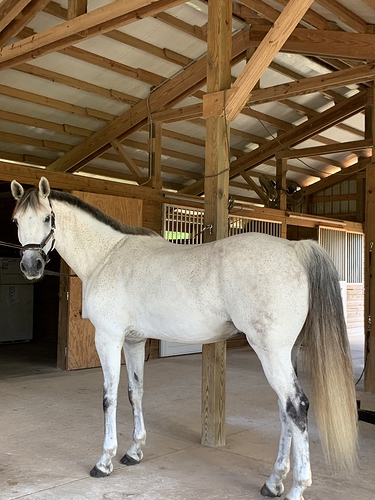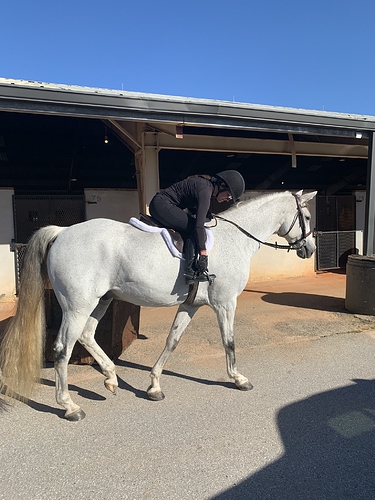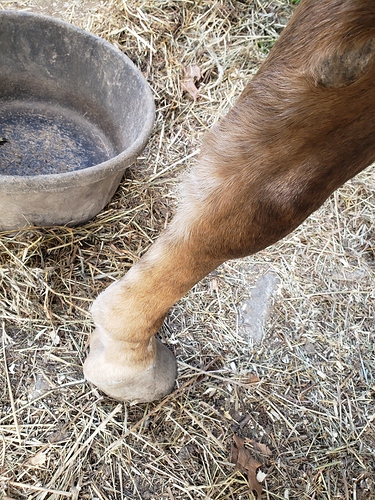Hi experts,
I know dapple grey horses lose their dapples with age. I have a dark bay with plenty of dapples. Her sire was a dapple grey. Will she lose these dapples as she ages? She’s 13 now.
No. Dapples in bays are more a sign of a glossy healthy coat. Whereas a grey horse loses his dapples because of the darker color turning to white
No. If your horse had inherited the gray gene, she would be nearly white by now.
Bays typically change a few shades from summer to winter coat, but only gray fades right out over the years.
Dapples are a combination of genetics and good health so as long as your mare has good nutrition and weight, she should be dappled at least in summer. Winter hair can hide them.
Most colors are stable over the adult life of the horse, with seasonal changes for winter and summer coat and sometimes summer fading. The exception is appaloosas who can both grow and lose spots over time.
What a beauty! Thanks for the answer. I’ll look for them next spring!
You know we need a picture of your lovey right ?
Pretty please !
We have found the dapples on our bay horses to be related to their fitness. When in good, competitive fitness, they were extremely dappled. Stayed lacy dappled even body clipped! But when winter came, not worked much, the dapples faded. With older age, minimum work, they have almost no dapples these days, though still darker bays.
Years ago the fitness medical folks said dappling was related to circulation, aiding the ability to cool horse down better. Our horses did CDE things at higher levels, with limited cooling time between sections. So dappling and water cooling did help reduce temps faster.
But most of ours, with a couple exceptions, have not stayed dappled much with age, 18+ years. The exceptions were related, very dark bays, used to be seal-bay before all the new color names came along! The 2 half sister mares and 2 geldings from these mares all were the same dark bay color, looked black bodied unclipped, except for the dapples. They stayed dappled into old age, 28yrs. They just were “less” dappled older, than when they were in very fit, competition condition.
bays and chestnuts (and even blacks) tend to have seasonal dapples - they come and go with the changing of the coat, as it’s a function of the capillary patterns which have a bit more heat, which makes hairs shed at different rates, so you get the dappled look and it’s usually more pronounced with the Winter shed/Summer growth, since the old hair is longer and darker (in these colors0. Once full shed/growth cycle is done, the dapples disappear
Hormones can also cause extra dappling. My TB mare kinda sorta dappled with the seasons, but early Fall the year she was pregnant she was LOADED.
Cream has a different effect outside of seasonal coat changes. Palomino and buckskin are often really dappled in their lighter Winter coat, the whole season, and little to no dapples in their darker Summer coat.
2 palominos here. Feronia gets seasonal dapples that fade as her winter coat grows in. Lola is covered with dapples, but I literally just bought her yesterday, and she has a full body clip, so??? Based on photos of her palomino relatives, my guess is she will keep her dapples through the winter. They are very different shades, though. Feronia is pumpkin-orange, while Lola is lighter and sooty.
Many years ago I boarded at a barn where a guy had an aged - 25+ - gray. Horse was nearly white.
Imagine my surprise when he showed me a photo (with date stamp) of a dark bay & told me it was the same horse. 
Was he pulling my leg?
My 23yo Hackney has gone very gray on his face & I’m noticing scattered gray on the face & neck if the dark bay TWH.
I wonder how much grayer each will end up 
Genetics and nutrition both have a huge roll in dappling.
The genes that control red and black pigment in the hair respond to dietary changes, thus the dapples. It’s a genetic variant that depends on nutrition, environment (grooming and hygiene), and fitness. They will come and go as changes occur in nutrition, environment and conditioning. But your horse will not lose them for good. With proper conditions, they will come back, because your horse has the genetic variant to allow it.
As for the grey color concerns. The grey gene is really a disease of the pigment. As far as I know, there is no information on how fast/slow the pigment changes can happen, and that it ranges from horse to horse. By 13, if there has been no changes towards grey, your horse did not inherit the gene from their N/N or N/G parents. If the sire was grey, he had to have been N/G to avoid passing it along as it’s autosomal dominant. It only needs one copy to express.
All gray horses end up white, and those that are heterozyous gray often end up fleabitten, as the g (not gray) gene regains some ability to produce pigment. All gray horses start out as a “regular” color, and as gray is a pigment disease which destroys the ability of to make hair/coat pigment, each subsequent new set of hairs is lighter and lighter until there’s no pigment
not anywhere near gray horse gray.
Here are some articles that talk about dapples. Fitness, sootiness, and grooming
a body clip will show the dapples more.
Stunning horse and the reason I try to avoid grey stallions  God forbid ones amazingly looking foal starts to fade one day. This year I got a stunning filly by a grey with beautiful white markings on the head and I am so happy she stays bay
God forbid ones amazingly looking foal starts to fade one day. This year I got a stunning filly by a grey with beautiful white markings on the head and I am so happy she stays bay 
I understand completely!! He is my first and only grey.
I always wish they’d keep that dark gray dappled look. It’s so amazing.
Agreed!! as a child my first Breyer horse was a dark dapple grey. I’ve always coveted that color. Until I owned it. And it turned white and sleeps on a  pillow every night and lives to make himself look like a crime scene.
pillow every night and lives to make himself look like a crime scene.
For me, it was a lease horse that would somehow turn most of his body dark green, and the rest manure brown. It was like a green/brown pinto pattern every day.




